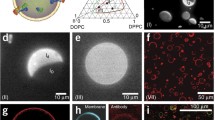Abstract.
The morphology of supported planar bilayers has been investigated below phase transition temperature by atomic force microscopy in contact and tapping mode. The bilayers were formed by the vesicle-spreading technique. In contact mode at low scanning forces of about 1 nN true molecular resolution could be achieved for supported phosphatidylcholine bilayers. The resolution was confirmed by experiments that captured the location, average area of individual lipid headgroups and the manipulation of the bilayer surface. Repeated scanning in contact mode shifted the random topology of the surface consecutively to a striped pattern. Height profiles of defect-containing bilayers were analyzed. The shape of the defects became smooth by repeated scanning. The height profiles allowed the estimation of the indentation of the tip into the surface-adsorbed membrane. In tapping mode a disordered pattern of headgroups became visible. Our morphological data at molecular resolution suggest that the native arrangement of the choline headgroups is disordered, free of large packing defects and becomes ordered in Schallamach waves by scanning in contact mode.
Similar content being viewed by others
Author information
Authors and Affiliations
Additional information
Received: 12 March 1997/Revised: 3 October 1997
Rights and permissions
About this article
Cite this article
Beckmann, M., Nollert, P. & Kolb, HA. Manipulation and Molecular Resolution of a Phosphatidylcholine-Supported Planar Bilayer by Atomic Force Microscopy. J. Membrane Biol. 161, 227–233 (1998). https://doi.org/10.1007/s002329900329
Issue Date:
DOI: https://doi.org/10.1007/s002329900329



